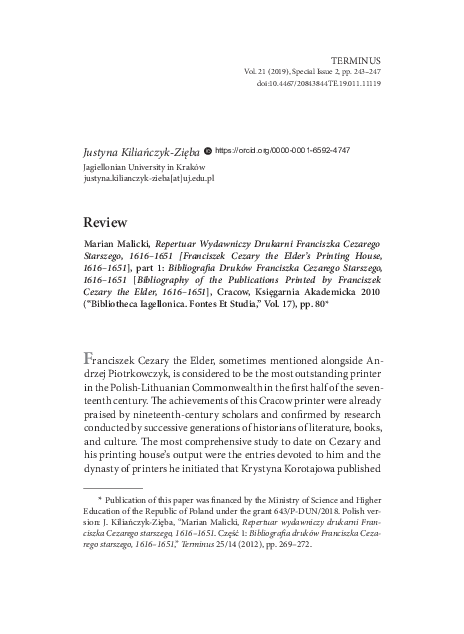Academia.edu no longer supports Internet Explorer.
To browse Academia.edu and the wider internet faster and more securely, please take a few seconds to upgrade your browser.
Marian Malicki, Repertuar Wydawniczy Drukarni Franciszka Cezarego Starszego, 1616–1651 [Franciszek Cezary the Elder’s Printing House, 1616–1651], part 1: Bibliografia Druków Franciszka Cezarego Starszego, 1616–1651 [Bibliography of the Publications Printed by Franciszek Cezary the Elder, 1616–165...
Marian Malicki, Repertuar Wydawniczy Drukarni Franciszka Cezarego Starszego, 1616–1651 [Franciszek Cezary the Elder’s Printing House, 1616–1651], part 1: Bibliografia Druków Franciszka Cezarego Starszego, 1616–1651 [Bibliography of the Publications Printed by Franciszek Cezary the Elder, 1616–165...
2019, Terminus
Related Papers
2021 •
2020 •
The letter of dedication constitutes an important element of the editorial framework of the old printed book. It was a tool meant to serve its author or publisher to achieve specific goals relevant to them. It was also frequently found in the publications of the Lublin Jesuit Printing House. Content analysis of this type of texts provides us knowledge about the circle of authors and addressees, the relationships between them, the environments from which they come, as well as the reasons for their writing activity. The biographical data included in them is a valuable source allowing for gaining a fuller understanding of the profiles of more or less recognized figures coming from different environments of the former Commonwealth of Poland.
2012 •
Revised edition of the book from 2011. Authors: A. Rzepka, R. Sosnowski, P. Tylus
The Polish Review
Writing History in Medieval Poland: Bishop Vincentius of Cracow and the Chronica Polonorum2020 •
Z Badań nad Książką i Księgozbiorami Historycznymi
Slovak humanist Ondrej Rochotský (ca. 1583-1623) and his works stored in the Wrocław University Library2018 •
The article discusses manuscript books – collections of public life materials created in the 17th and 18th centuries in the Grand Duchy of Lithuania, now located in Poland. They were created mainly by nobles and by chancellery clerks and officials employed at magnates’ and state dignitaries’ courts as an expression of the interests of collectors or documentary and historiographical concerns, and sometimes also as support for public activity. They contained various materials related to conducting, documenting and recording public life. The present overview is based on an identification of copies and on the information contained in printed and online manuscript catalogues and inventories. The number of surviving manuscripts of that type can be hypothetically estimated at ca. 400–500 copies, with ca. 100 copies identified in Poland. Their largest collection is held in the Radvilos Archives, part of the Central Archives of Historical Records in Warsaw, with single copies scattered acros...
Orthodox Europe - Ορθόδοξη Ευρώπη - Orthódoxi Evrópi - Православная Европа ISSN 2545-3823
The Way of an Exemplar of the First Book of the Suprasl Typography to the Habsburg Empire - Droga egzemplarza pierwszej książki drukarni supraskiej do Cesarstwa Hasburskiego2019 •
The Way of an Exemplar of the First Book of the Suprasl Typography to the Habsburg Empire The first book (a Liturgicon) had begun to be printed in Vilnius in 1692 which were shown on the title page, then the pressing of the body were finished in Suprasľ, 1695, according to the colophon. The printing policy of the monks of Basilian Order was evidenced by a very complete example of the first Liturgicon, too, which were found by the author in the Rome Catholic Library in Eger, North Hungary. The rich Rome Catholic bishops provided the poor Uniate Greek Catholics (of Byzantine Rite) of Mukachevo by education. Thus a lot of service books printed in Church Slavonic got into Eger Library, according to the archival data were studied by the author. While the Liturgicon 1692-1695 contained some etchings depicted the Heart of Jesus and other Catholic symbols, the same engravings were used for the second edition printed in Unev, 1740 (҂AѰМ), too, but all these Western symbols were removed. (It is to be illustrated in the paper hence examples of both editions are held in Hungary, too.) Droga egzemplarza pierwszej książki drukarni supraskiej do Cesarstwa Hasburskiego Druk pierwszej księgi (Liturgikon) został rozpoczęty w Wilnie w 1692 roku, co zostało ukazane na stronie tytułowej voluminu. W całości edycja została zakończona w Supraślu w 1695 roku. Politykę drukarską mnichów z Zakonu Bazylianów potwierdza pełny egzemplarz pierwszego Liturgikonu, który został znaleziony przez autora w Bibliotece Katolickiej w Egerze (północne Węgry). Bogaci katoliccy biskupi zapewniali duchownym unickim (obrządku bizantyjskiego) z Mukaczewa edukację. W ten sposób wiele książek drukowanych w języku cerkiewnosłowiańskim trafiło do biblioteki w Egerze. Liturgikon z lat 1692-1695 zawierał ryciny przedstawiające Serce Jezusa i inne symbole katolickie, które ryciny zostały użyte do drugiego wydania w Uniejowie w 1740 roku. W wydaniu tym wszystkie te zachodnie symbole zostały usunięte. Fakt ten ilustrują dwa Liturgikony znajdujące się na Węgrzech.
RELATED PAPERS
Marxism and Sciences
From Abstract to Concrete: The State as an Unquiet Ideal2024 •
2024 •
Children, Dogs and Education
Ameliorating Children’s Stress and Trauma: Roles for Dogs in Counseling, Therapy, and Disaster Relief2018 •
2021 •
Ophthalmology and therapy
Novel Insights in the Management of Vernal Keratoconjunctivitis (VKC): European Expert Consensus Using a Modified Nominal Group Technique2023 •
ICH M4S-人用药品注册的普通技术文件: 安全性 模块 2 的非临床概论和非临床摘要 模 块 4 的组织 海南碧凯药业有限公司 唐军翻译
ICH M4S-人用药品注册的普通技术文件: 安全性 模块 2 的非临床概论和非临床摘要 模 块 4 的组织 海南碧凯药业有限公司 唐军翻译2020 •
Biochimica et Biophysica Acta (BBA) - Bioenergetics
Kinetics and ion specificity of Na+/Ca2+ exchange mediated by the reconstituted beef heart mitochondrial Na+/Ca2+ antiporter2004 •
Open Journal of Obstetrics and Gynecology
Sexual Function in Pregnant Women in the Public Health System2019 •
International Journal of Molecular Sciences
COVID-19 Vaccines, Effectiveness, and Immune ResponsesJournal of Mechanical Engineering Advancements
Exploring MRR in Wire EDM of Titanium Grade 5: A Statistical Analysis2024 •
Expert Review of Proteomics
The application of proteomics in muscle exercise physiology2020 •
RELATED TOPICS
- Find new research papers in:
- Physics
- Chemistry
- Biology
- Health Sciences
- Ecology
- Earth Sciences
- Cognitive Science
- Mathematics
- Computer Science

 Kaja Szymanska
Kaja Szymanska